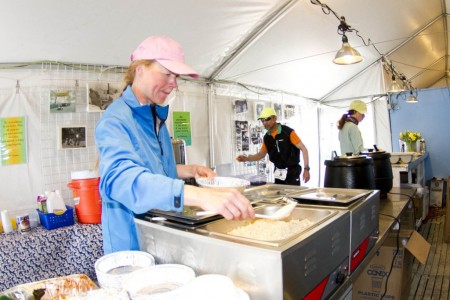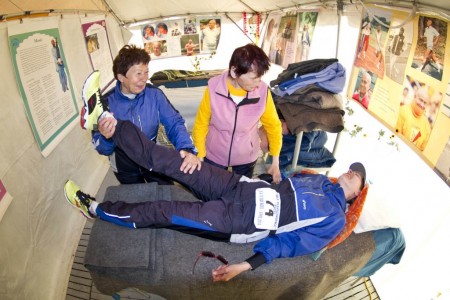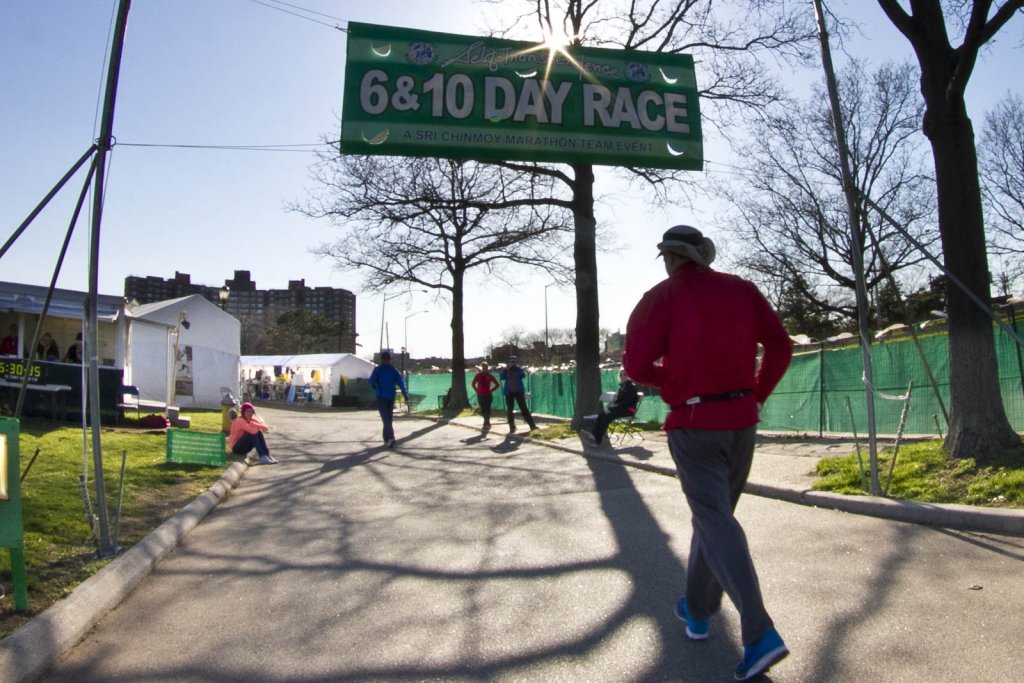Once we master the art
Of going beyond ourselves,
Nothing any longer
Can create any problem.
Indeed, this is a supreme discovery.–Sri Chinmoy ((Sri Chinmoy, Ten Thousand Flower-Flames, Part 12, # 1152, New York: Agni Press, 1981))
Ultra-running is one way of “going beyond ourselves.” In the last two weeks I have seen how happy people are when they transcend themselves in the running world, and how even their various helpers and supporters feel happier than usual. The Self-Transcendence Six and Ten-Day Races took place in Flushing Meadows-Corona Park, Queens, New York from 19 April – 29 April, 2014. Eighty runners from over 15 countries, including Nepal, Ireland, Brazil, Romania and Russia, finished either the 6-day or the 10-day race this year. These races have been annual events for 17 years (the 6-day) and 19 years (the 10-day), open to super-athletes, both Sri Chinmoy’s students and others.
The runners keep going for six days, or ten days, depending on which race they have chosen to participate in. They do bring small tents which they set up in the temporary “village” which exists to empower the event, and they take naps in their tents from time to time; but basically, they keep going all day and all night. A support team of over 100 rotating volunteers helps the athletes in various ways. The four Race Directors organize and supervise everything. Medical assistants provide chiropractic care, massages, soothing herbs and moral support. ((Corey Kilgannon, on p. 4 of the Metropolitan section of The New York Times for Sunday, 26 April 2014, reports on an interview with a helper, now 72 years old, who has volunteered in the medical tent at this race since its inception. Article available at: http://www.nytimes.com/2014/04/27/nyregion/healer-at-the-pit-stop.html ))

Runners grab some food from the race kitchen
A cooking team provides vegetarian meals for participants as well as the other helpers. Teams of “counters” note the time at which each runner completes each lap, which serves to qualify the races as certified road races. Electricians and handymen set up the temporary buildings that house the cooks and the counters, and make sure that the lights and the stoves stay on, and that vulnerable spots are covered with plastic when it rains. A “watcher” is stationed at night, at the point on the one-mile-loop that is furthest from the village, so that the runners do not space out and lose their way in the dark. Various people clean up the assorted debris. A driver drives back and forth between the Sri Chinmoy Centre in Queens and the race site several times a day, ferrying other helpers to and fro. Some participants bring their own personal assistant(s), persons who self-givingly take care of the runner’s laundry, and organize drinks, snacks and supplements for their runner, and have these items in their hands, ready to be dispensed, as the runner passes by the temporary shelters where each runner has a designated station.

A runner being looked after in the medical tent
Musicians come, from time to time, to play their instruments or sing. Photographers visit with cameras, to provide a visual record of the event. Other visitors stop by just to cheer the runners on, or to watch their progress. ((To read more about the details of these races, search for either ‘6 and 10 day race’ or ‘Perfection Journey’. The former records the daily results for the runners, and the latter offers day-by-day insight into the race, along with photographs of and interviews with some of the runners.))
This is the physical set-up, but what I really want to describe is the level of happiness that pervades the entire race area. As I approached the village one day last week, it seemed to me that feelings of peace and joy were radiating out to the park at large. You might imagine that the runners, each of whom has run at least one marathon a day for the last several days, might be groaning and miserable. Not at all! They look cheerful, smiling at the visitors, offering thanks to the cooks, the musicians, the counters. If they had been stressed and disappointed the first time they took part, they would never have come back, but many of them have returned to this race year after year, some for over ten years. Similarly, the cooks, who are doing things like stirring pasta in pots large enough to serve over 100 people, look as if they are enjoying themselves; and their food tastes good, a sure measure of the cook’s state of mind, in my opinion. The counters are sitting in one place, for four or five hours in a row, their attention firmly focused on their runners, anxious not to miss a single lap, but they too are smiling and energized, shouting praise and encouragement to their runners, and they, too, return year after year. The personal assistants, unlike some of the runners, will never record a “personal best” at this event, but when their runner stays up half the night, they do too, and they say they like it; sometimes when their runner is sleeping, they volunteer to help the counters, the cleaners or the electricians.
Sri Chinmoy, the author of Jewels of Happiness, a meditation Teacher who was also a master athlete, often spoke about running as a metaphor for the spiritual life. I myself am not an athlete, I am a retired professor and researcher. But after counting at this event several times in the last two weeks, I am more than ever convinced that to dedicate ourselves to self-transcendence in any aspect of our lives is one of the surest ways to find happiness.

